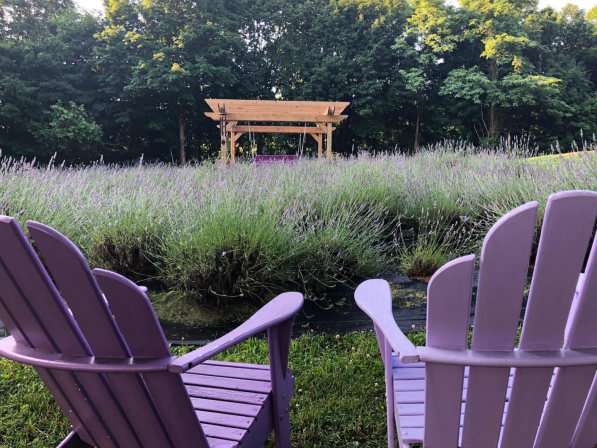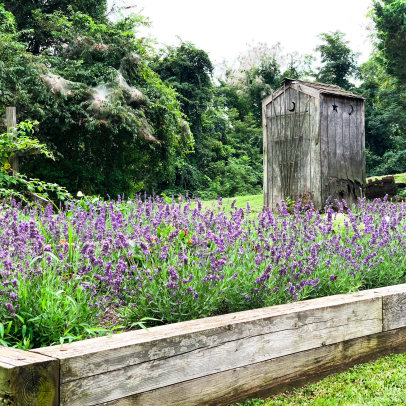|
|
|
|
 Lavandula x intermedia Lavandula x intermedia'Grosso' |
3. Choose the size of the plants to buy
The kind of plant you choose will depend on how you’d like to grow lavender and what your goal is. For example, are you growing lavender in pots, growing a lavender field, or growing lavender as a cash crop? All of these are possible! If you want to plant a whole lavender field, 1-inch plugs or 2.5-3.5 inch pots will be the most affordable way to fill a large space. Both of these, especially the 1- inch plants, will require plenty of water and attention in the first year until they’re established. If you’re looking to make an immediate impact in your landscaping, look for larger 1-gallon size plants. These more mature plants will give you an explosion of color and fragrance right away. Note: we don't recommend growing lavender from seed. French lavender can't be grown from seed since it is a hybrid and English lavender seeds take a long time to germinate and grow.
4. Best to wait a few weeks before planting
You’ve just purchased some lavender plants, and you’re so excited to see them in your garden. But be patient – leave your plants in their pots for a few weeks so they have a chance to acclimate to the weather and to ensure that they are healthy before planting them.
5. Choose a spot with lots of Sun

Keep in mind that lavender originally comes from the Mediterranean, and it thrives in that Mediterranean sun. What that means when you grow lavender at home is that you need a spot where the plants will receive at least 6-8 hours of sunlight. Southern exposure is usually the best. Whether you’re planting your lavender in pots, a field, or a garden, this sunlight is key.
6. Make sure your soil provides enough drainage

The number one cause of lavender plants dying is wet roots. If your soil doesn’t drain well, water will accumulate and cause the roots to rot. Take a look at your soil: is it clay? sand? The best soil for lavender is a dry sandy loam soil, which is a nice balance of sand, clay, and organic material. Sandy soil works well, but if your soil is heavy clay, you’ll need to add small pebbles or grit to break up it. Note - don't add sand to clay soil or it will become like cement.
8. When to plant lavender
You want to plant lavender either in the spring or, for blooms the following year, in early fall. For spring planting, wait until the danger of frost has passed. In the fall, you want to plant before the weather gets too cold, typically before September 1 st in the Northeast or 6 weeks before your first frost.

9. How to plant lavender
Lavender’s roots don’t need much room, so if you’re planting in the ground, dig a hole just large enough for the root ball. If you’re growing lavender in pots, choose a pot just a little larger than the size of the roots. You can re-pot to a larger pot next year as the lavender grows. If you’re planting a lavender field or a whole row of lavender, you should leave about two feet between each plant. This will give them room to grow. You can either plant your lavender without mulch or use a light, thin layer. Pea gravel or oyster shells work better than wooden mulch. A thick layer of mulch will trap in too much moisture.
10. When to water lavender

How often to water lavender depends on how old the plant is. For newly planted lavender, water every other day for the first week as the plant adjusts. Then water every 3 days for the first few months. If it has rained, you can skip watering. If you’re growing potted lavender, you should water when the soil is bone dry. When you water, you want to water thoroughly so that the roots are saturated, then let the soil dry out between watering. For established plants, you only need to water every two weeks. If you have regular rainfall, you may not need to water at all.
11. Fertilize lavender sparingly
Lavender only needs a little fertilizer. You can fertilize once a year in the early spring. Use a high-quality compost or a slow-release fertilizer, and you’re done!
12. Enjoying your lavender – how to harvest
You may simply want to leave lavender in your garden for you and the local bees to enjoy. But if you’d like to use your lavender, harvesting is quite simple. When the flowers are about a third of the way open, use a pair of pruning shears to cut the stalks at a point just above where they become woody. Then you can tie your lavender into bundles and hang them upside-down for about two weeks to dry. Then your lavender will be ready for cooking, making essential oil, creating sachets, or any other lavender projects.
 |
 |
13. Prune annually

If you’re looking for the secret to how to grow big lavender, you need to trim the plants back every year. Even though it feels counterintuitive, pruning significantly will enable the plant to grow bigger and bushier over time and also to live longer. After the plants have flowered, use a pair of pruning shears to prune the entire plant back by at least one third. You want to prune to just above the wood base, where the green growth stops. Next year, your lavender plant will grow back bigger and stronger!
Enjoy!
In the years that I have been growing lavender, I’ve learned that nothing is full proof but hopefully, these tips and techniques will help ensure your success.
If you need more information or have questions – please visit us at www.mtairylavender.com or contact me personally at [email protected].

 Mt Airy Lavender was created by sisters, Amy Saha and Joanne Voelcker to share the beauty of their family farm and the pleasures and benefits of lavender. Located in Coatesville, Pa with over 1,500 lavender plants, their lavender is organically grown and distilled on the farm to make beautifully packaged products and gifts that are perfect for treating yourself or special friends and family. Amy is a certified floral designer and Joanne and Amy are active members of the US Lavender Growers Association and often speak at USLGA conferences, garden club meetings and other events.
Mt Airy Lavender was created by sisters, Amy Saha and Joanne Voelcker to share the beauty of their family farm and the pleasures and benefits of lavender. Located in Coatesville, Pa with over 1,500 lavender plants, their lavender is organically grown and distilled on the farm to make beautifully packaged products and gifts that are perfect for treating yourself or special friends and family. Amy is a certified floral designer and Joanne and Amy are active members of the US Lavender Growers Association and often speak at USLGA conferences, garden club meetings and other events.
Shop online for our wellness, beauty, and culinary products and find information, inspiration, and announcements of events and workshops at www.MtAiryLavender.com




 Lavandula angustifolia
Lavandula angustifolia